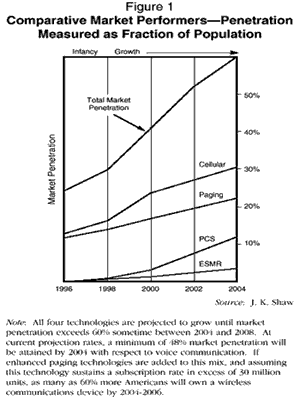
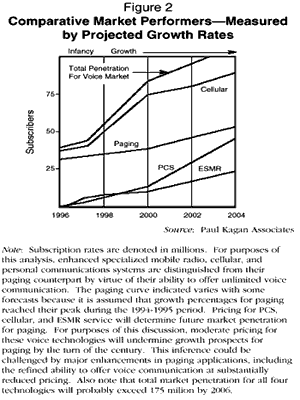
The cellular industry, emerging in 1983, has benefited from the absence of direct competition in the "voice" market. In the 12 years following the advent of cellular communications, only enhanced paging services have directly impinged on the growth of the cellular market and its resultant penetration. In recent years, the paging industry has produced market growth that has exceeded that attained by its cellular counterpoint, characterized by a vigorous pricing strategy.
The cutting-edge of uncertainty in the industry today concerns the prospective development of SMR and PCS.
These are among the ambiguities implicit in data now surfacing from private researchers, corporations, and government agencies.3
Mounting empirical evidence suggests that virtually all Americans, without regard to age or other significant independent variables, are prospective candidates for wireless services. As noted in the body of data and other information herein, the industry has all of the intrinsic advantages associated with dynamic growth industries based on emerging technologies:
We may reasonably infer from the data that the key determinant for optimal market penetration is pricing; thus, the competitive positioning of the four key players will ultimately be a function of that technology which sufficiently lowers price to accommodate the broadest consumer base. Within reasonable parameters of quality and service, price will be the key independent variable responsible for market penetration. The public wants and needs the value-added services -- instant communication, security, access, information, mobility -- that only this industry can promote.
It is for this reason that the FCC has continued to allocate -- at first through essentially "free," now auctioned licensing -- electromagnetic spectrum.6
Specialized mobile radio, originated in 1974 as essentially dispatch designated spectrum, has grown modestly in recent years, but is now poised for geometric growth. Major industry players -- Nextel, OneComm, and various regional providers -- have accumulated SMR licenses throughout the country to form networks potentially competitive to cellular providers. The absence of sufficient spectrum and continuing technical problems have hampered the growth of the industry, but one certainly cannot rule out rising prominence for these competitors should technical problems be relieved.
The enormous spectrum allocated to PCS, dwarfing the combined bandwidth of SMR, cellular, and paging, underscores the greatest potential competitive threat to the voice duopoly. The multiplicity of PCS license holders in each metropolitan market, however, along with serious issues of capital availability, probably means many years will be required to seriously erode cellular's present "leader" status. The variance in competitive advantages and disadvantages may be seen more concretely in Table 1.
| Table 1: Competitive Advantages and Disadvantages | ||||
|---|---|---|---|---|
| Cost of Business per Subscriber | Bandwidth | Pricing | Competitive Structure | |
| Cellular | High | Moderate | High | Duopoly |
| Paging | Low | Minimal | Low | Multiple* |
| PCS | High | Extensive | Moderate | 3 to 6* |
| SMR | Low | Minimal | Low | Multiple* |
| * Depends on location. | ||||
| Source: J. K. Shaw | ||||
In sum, the cellular, SMR, and PCS industries will divide and shift market share in response to comparative pricing strategies. Pricing will depend very heavily on the established competition unique to each urban, suburban, and rural area. With the recent completion of PCS auctions (a handful of PCS and SMR licenses remain to be auctioned), we are gaining a clearer sense of the positioning of the players. It is comparatively more expensive to build out and maintain cellular and PCS systems as opposed to their SMR and paging counterparts. However, barring major technological improvements in paging and SMR, these latter providers will remain niche players, despite implicit pricing advantages (they control insufficient spectrum to capture substantial market share in the short term). Despite financial and technical constraints, each wireless technology will nevertheless influence price and resultant market share. Taking these advantages and disadvantages in totality, cellular retains the greatest competitive advantage at present. The "head start" it has gained through 13 years of development has produced a seminal, formidable technical and financial knowledge of the market.
A visual depiction of these data underscores the enormous growth projected by Kagan and others (see Figures 1 and 2). We note that cellular's growth continues unabated until the year 2000. Thereafter, its growth rate diminishes somewhat as PCS and SMR take hold. The concurrent growth in paging remains a matter of debate and contention; we cannot estimate precisely the role of a lower-priced competitor during an era of rising competition between three dynamic players. Is paging posed to capture a "low-end" market, or will it simply be supplanted by a competitor that performs a multiplicity of functions at a declining price? The market penetration rate graphed in Figure 1 for paging presumes continued growth that probably will not diminish until after 2000. In any event, some 60% of the American population could be using one or more communications devices sometime between 2004 and 2006.


By this estimation, as many as nine out of 10 eligible consumers would secure a wireless communications device sometime during the period running from 2006 to 2010. There is some implicit imprecision in this forecast -- technical problems could impede market growth, for instance -- but the dynamics of market acceptance underscore a credibility to the prediction. Even in the absence of significant contributions by SMR and PCS, the industry has already attained a 25% penetration rate when paging is factored with cellular subscriptions.10
In Figure 3, we can isolate an S-curve that suggests 90% market penetration for wireless services not later than 2012. A comparable penetration rate could be achieved earlier, of course, if price dropped sufficiently to expand the market base. There are ample precedents for similar and dramatic S-curves throughout history: radio, television, and the videocassette recorder all achieved 90% market penetration defined by a timeframe consistent with the S-curve. The years required to gain a 10% market share approximate the number of years required to move from a 10% to 90% market share.
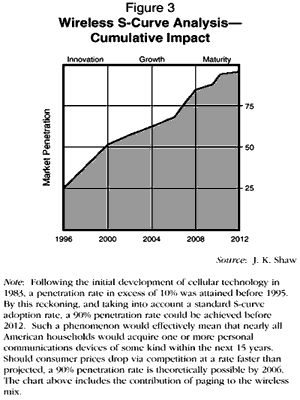
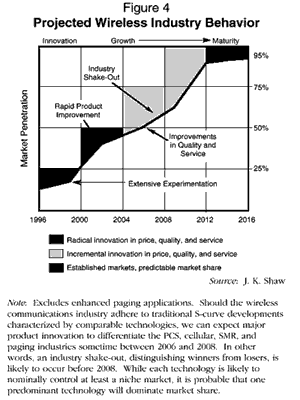
When the S-curve for wireless communications is adjusted to exclude paging services (see Figure 4), a tactic employed to specify the potential market for voice communications, we note a series of "steps" that market participants are likely to embrace. As the industry unfolds after 1996, we identify the origin of radical innovation in quality, pricing, and service for wireless services. As market share expands, an industry shake-out is inevitable. Before 2008, and perhaps as early as 2004, we are likely to see a substantial number of mergers, acquisitions, and strategic alliances which will only diminish as we approach 90% market penetration. It appears probable that the impending chaos of these consolidations will only abate when we move from 2008 to 2012.11 The period of maturity which follows thereafter will be characterized by established markets and predictable, sustained market shares. There will be a place for all three primary voice technologies with reliable hardware retaining versatile functionality.
Should this S-curve scenario unfold in a manner characteristic of other mass consumer markets, we cannot identify with certainty the "ultimate victor." The winner, in the era of mature and established markets, most probably will be either cellular or PCS. Their control of spectrum imparts, with or without major engineering refinements, a strong advantage in this environment. In this case, the consolidations which follow radical innovation during the next eight years will probably determine the dominant market technology. By this time, it may well be immaterial which technology "wins" such a battle. We may well have networks that are indifferent to the hardware which sends or receives wireless messages. Corporate consolidations resulting in control of spectrum may well be regarded as the most important determinant of market dominance during this era.
As previously indicated, that point on an S-curve which represents a transition from concave to convex growth signifies a diminished growth rate. These inflection points signal vulnerability to a market leader in a rising consumer market in which competition mounts. We note such an inflection point for cellular technology in the year 2000. Although cellular continues to grow at a substantial rate, PCS and SMR technologies accelerate their growth and penetration rates in a rising tide (see Figure 5). This period, 2000-2006, will be an era of severe competition where the market leader will have to innovate in response to aggressive emerging technologies. It is improbable that cellular can capture more than one-third of total market share during this period, and it is a distinct possibility that PCS (exploiting its bandwidth and economies of scale) could significantly erode cellular market share. Continued technical improvement with commitment to marketing and after-sales service will define market success during this period. It is quite possible that market share will be volatile during this era, with SMR and PCS capturing an expanding market at cellular and paging's expense. It is unclear whether the rising prominence of these alternative technologies will reflect a niche status or serious threat to cellular's long-term survival.
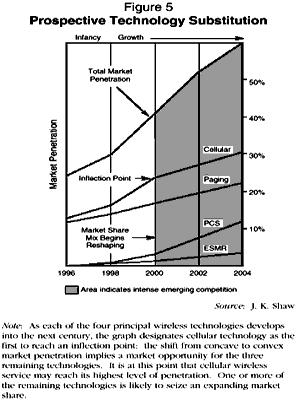
Should business consolidations reduce the number of PCS providers to two or three per market (rather than the four to six participants now licensed), PCS could be the "natural substitute" for cellular telephony. With ESMR relegated to a largely niche dispatch role, a fight between cellular and PCS for rising market share in an exponentially growing market seems inevitable. To succeed as a "substitute," PCS must make its mark (note cellular's inflection point and diminished arc) during the first six years of the next decade, and its most serious obstacle is the presence of so many "sister competitors." Therefore, the extent to which PCS will succeed will depend to a large degree on its capacity to sort out viable, consolidated competition to the enduring duopoly.
Historically, companies have hesitated in "jumping" to a new S-curve for a number of reasons. Often, product improvement that might have resulted in an elegant move from established to new S-curves has been thwarted by:
Cellular providers could be undermined by overconfidence during the next decade if they presume that PCS, paging, and SMR providers can achieve no more than marginal market shares. Success often spoils leaders who presume that their early entry to market secures permanent advantage. No such presumption is valid in the wireless industry.
It has often been assumed that the most effective way of capturing a rising market share in a rising consumer market is to innovate a technology, grow with the market, and dominate pricing in the early years of minimal competition. It is this tactic that has characterized the growth of the cellular industry since the 1980s. The primary disadvantage associated with this tactic is, of course, the extraordinary expense associated with product innovation and "consumer education." The front-end costs are seen as being fully justifiable during an era of an expansive S-curve.
Although PCS and ESMR are different forms of wireless telephony, they are essentially identical in their ability to offer consumers a similar multiplicity of services. Therefore, increasingly, it will be less significant as to who the market innovator has been, and it is possible through incremental improvement to compete with this established technology. PCS and ESMR have the opportunity to learn from mistakes made by the cellular industry: Technical, financial, and market lessons painfully learned in cellular can lead to sustained, incremental improvements for these upstart technologies.
It has become axiomatic in the computer industry, for example, that "first to market acceptance" is substantially more important than being first to market.12 Seventy-five percent of Americans do not have access to wireless communications at present, and it matters little to them which technology they employ. Consumers are interested in procuring that form of wireless telephony which, predictably, is predominant in pricing, quality, and service.
The ascending concave arc now characteristic of the industry S-curve affords competitors an exceptional and, perhaps, unprecedented market opportunity. It is unlikely that such an opportunity will return after the year 2006.